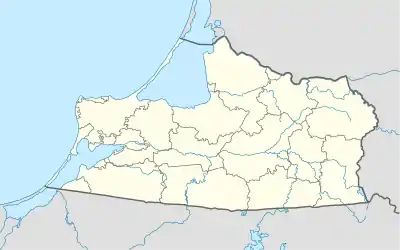Narmeln
Narmeln (Russian: Нармельн, Polish: Polski), alternatively known as Polski,[1] is an abandoned village in Baltiysky District of Kaliningrad Oblast, Russia. It is located on the Vistula Spit, on the border with Poland, the westernmost point of Russia.
Narmeln | |
|---|---|
Abandoned village (abolished) | |
_mi%C4%99dzywojnie.jpg.webp) View of Narmeln (before 1930) | |
Location of Narmeln 
| |
 Narmeln Location of Narmeln  Narmeln Narmeln (Kaliningrad Oblast) | |
| Coordinates: 54°28′01″N 19°40′06″E | |
| Country | Russia |
| Federal subject | Kaliningrad Oblast[1] |
| Administrative district | Baltiysky District[1] |
| Coaching inn | 1489[1] |
| Abolished | 1945[1] |
| Area | |
| • Total | 0.6 km2 (0.2 sq mi) |
| Population | |
| • Estimate (1970)[1] | 0 |
Narmeln is distinct as it is one of the few places in Kaliningrad Oblast whose German name was not officially changed when the territory was annexed to the Soviet Union following World War II, and is also the only part of West Prussia to be annexed by the Soviet Union by the Treaty of Potsdam. Narmeln was depopulated after the war, and the Soviet side of the Vistula Spit was made into an exclusion zone, which remains in effect today.
Geographical location
Narmeln is located about 35 kilometres (22 miles) south-west of Baltiysk. The westernmost point of Russia is located on the Poland–Russia border nearby. (54°27′29.4″N 19°38′21″E)
History
Coaching inn and border station
The southern part of the Vistula spit had been given around 1470 by the Teutonic Knights to the city of Danzig (Gdańsk). In 1489 the innkeeper Hans Voyte got the permission to open a coaching inn in a place called Ermelen. In 1525 Narmeln became the border station between the territories of Danzig in Royal or Polish Prussia and the Duchy of Prussia.
Narmeln was annexed by the Kingdom of Prussia in 1793, in the Second Partition of Poland. During the era of Napoleon Bonaparte the village became border of the free city in the period extending from 1807 to 1814. In 1815 it became part of West Prussia.
After the creation of the Free City of Danzig in accordance with the terms of the Versailles Treaty Narmeln was joined with the area around Elbing (Elbląg) to German East Prussia.
World War II

At the beginning of World War II Narmeln became a village again in West Prussia. In 1945 the spit has been the last holdout of the remaining German soldiers in East and West Prussia. After the occupation of Tolkemit (Tolkmicko) on January 26, the German refugees fled over the ice of the Vistula Lagoon from Passarge (Nowa Pasłęka) to Narmeln. The village was eventually captured by the Red Army on April 30, 1945.
Post-war changes
| Year | Pop. | ±% |
|---|---|---|
| 1905 | 242 | — |
| 1910 | 257 | +6.2% |
| 1920 | 274 | +6.6% |
| 1933 | 278 | +1.5% |
| 1939 | 294[2] | +5.8% |
After the war, the northern part of East Prussia passed to the Soviet Union and the German inhabitants were expelled. Narmeln was the only place in West Prussia, which had been transferred to the Soviets. Located almost on the border to Poland the village became a deserted place. Border crossings are not allowed on the spit, the Russian part is an exclusion zone.
Historical names
Ermelen (1489), Narmeln (after 1489), Narmeln, Polski (1660), Narmeln, Polski, Polsk (until 1945).
Nature
Narmeln had been famous for the largest moving dune with a height between 26 and 45 meters on the Vistula spit. In 1926 a youth hostel had been opened.
References
Notes
- Georg Mielcarczyk, Narmeln-Neukrug-Vöglers. Ein Kirchspiel auf der Frischen Nehrung, Bremerhaven, 1971. (in German)
- westpreussen.de: Narmeln (in German)
Sources
- Josef Nikodemus Pawlowski, Populäre Geschichte und Beschreibung des Danziger Landkreises, Danzig, 1885. (in German)
- Georg Mielcarczyk, Narmeln-Neukrug-Vöglers. Ein Kirchspiel auf der Frischen Nehrung, Bremerhaven, 1971. (Ostdeutsche Landgemeinden und Kirchspiele, Band 7) (in German)
External links
- Der Landkreis Elbing: Narmeln (in German)